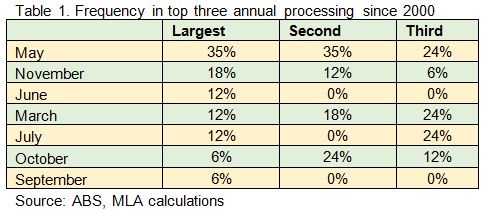Processing activity brews
May is typically one of the largest months in the calendar for Australian cattle processing, as peak northern and southern turn-off collides.
In fact, 94% of the time May is one of the top three largest slaughter months for the year, and in the majority of these occasions it’s actually in the top two. Table 1 illustrates the frequency when each month featured as one of the top processing months on an annual basis from the period 2000 to 2016.

With May 2017 now drawing to a close, the average weekly eastern states cattle slaughter for the month is just over 130,000 head, up 21% from April – which was induced by numerous public holidays. Nevertheless, the average weekly kill for May makes it the peak for the year-to-date and in line with expectations.
However, despite the recent rise, numbers are down 11% year-on-year and 17% from the five-year average. Even though this was inflated by the record cattle turn-off during 2014 and 2015, processing in May 2017 remains subdued in comparison to those of recent years.
Around the states, while the average number of cattle killed on a weekly basis during has lifted significantly from the Public Holiday inhibited April, May numbers remain below year-ago levels:
- Queensland is down 9%, averaging 66,602 head
- NSW’s down 9%, averaging 31,406 head
- Victoria’s down 24%, averaging 20,250 head
- SA is down 6%, averaging 7,507 head
- Tasmania’s down 2%, averaging 4,478 head
While rather varied, the next most frequent month since the year 2000 for the peak annual processing to occur is November (table 1), typically the result of the final surge in northern cattle hitting the market before the onset of the monsoon season.
Regardless of whether May or November eventually becomes the peak month, considering the very high probability of May being one of the largest processing months for the year, the recent brewing of numbers provides a good barometer of what the peak will be for 2017. Thus, with May averaging just over 130,000 head per week, anticipations that 2017 will be the lowest cattle processing year since 1996 are reinforced.



